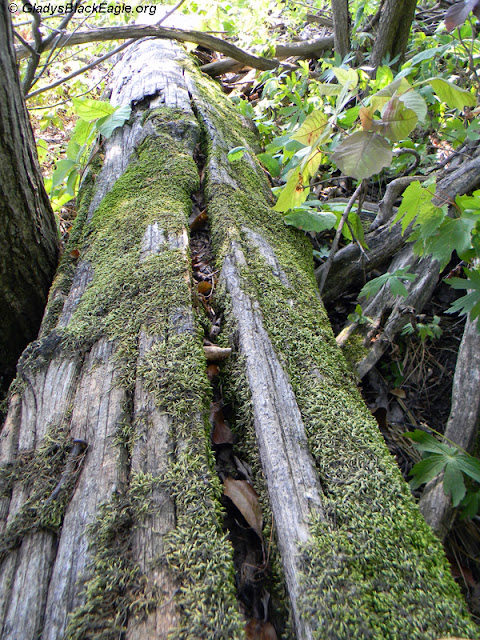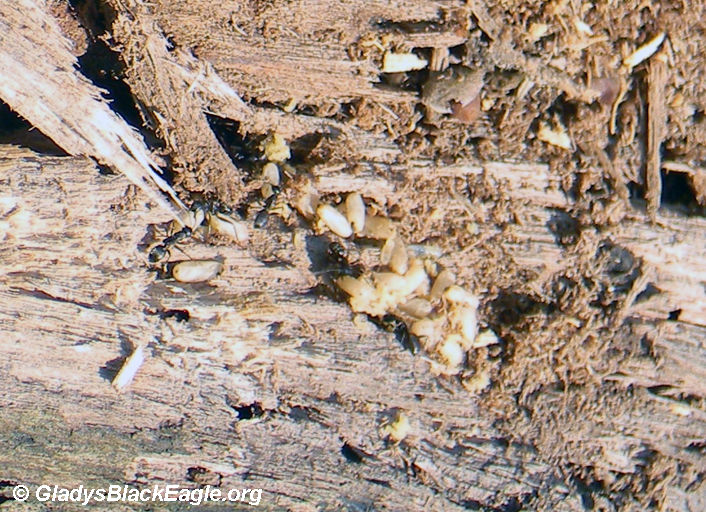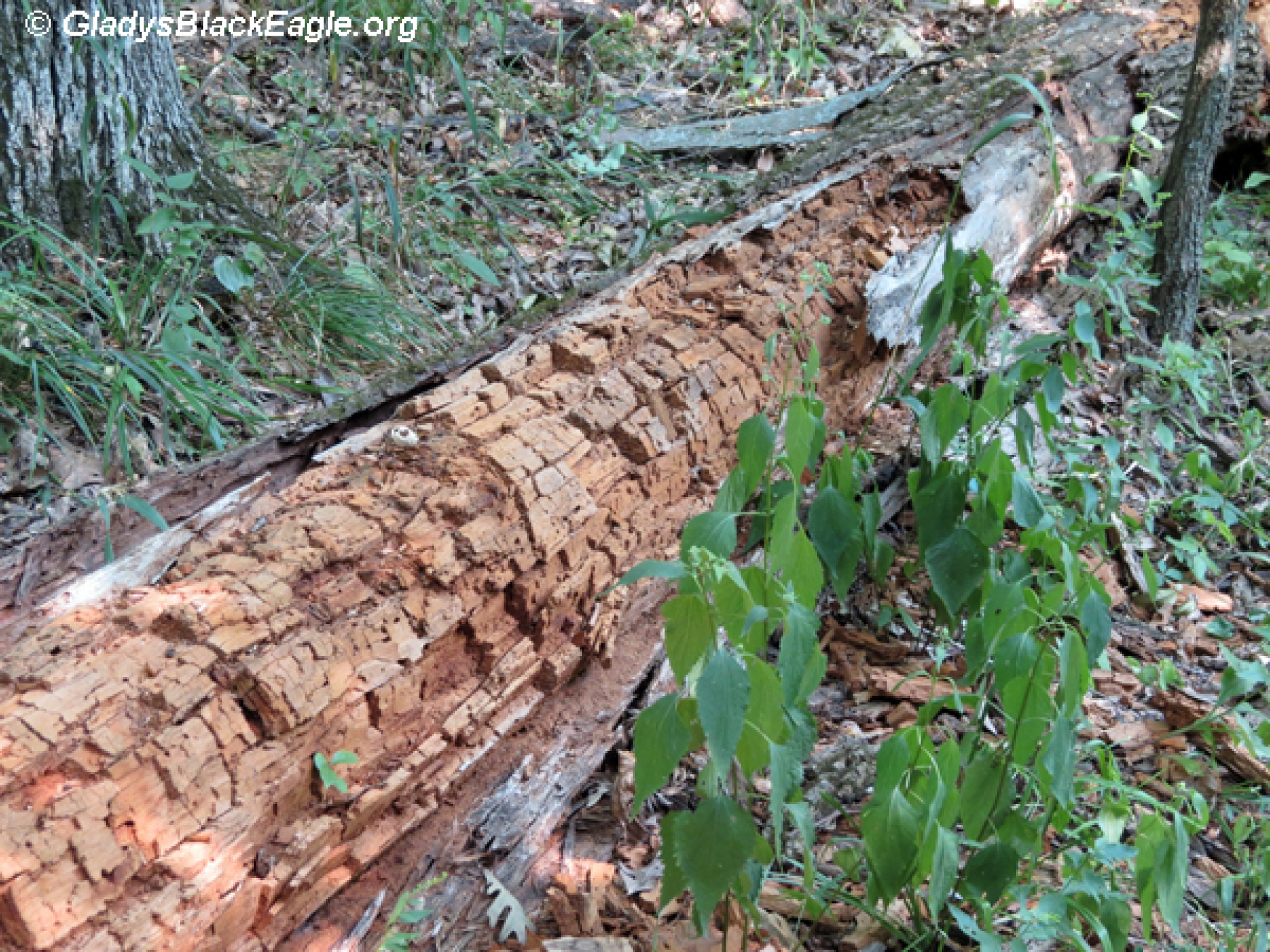Ecology of the Rotten Log
Marla Mertz, Marion County Conservation, and Linette Bernard, Feathers & Ink

The rotten log that you stepped over or around during your last walk in the woods is a community in itself. It looks lifeless and useless lying on the ground, but it actually harbors thousands of living organisms within and beneath it, maybe more than what the living tree did. Although many communities are big and complex, the small ones that form in and around fallen trees are fairly simple to observe and study. These mini classrooms provide perfect opportunities to learn about relationships between various organisms and how these relationships apply to many ecological concepts.
To clarify the importance of the rotten log, let’s look at some ecological terms:
-
- Ecosystem-defined as the living and non-living things that constitute a geographical area. These are broadly divided into terrestrial and aquatic habitats.
- Habitat-defined as an environment in which a particular organism lives. They are either major habitats or microhabitats. A habitat has the food, water, shelter, and space for an animal.
A microhabitat is a habitat within a habitat. An example is our rotten log found in a forest. The smaller rotten log has ideal living conditions for organisms including various species of invertebrates and fungi. The bigger forest is a major habitat in which bigger creatures such as deer, squirrels and other mammals, birds, reptiles, and amphibians may live. This habitat is differentiated from the microhabitat by the fact that microhabitats can only occur in major habitats, and not vice versa.
Now, let’s get back to the rotten log. It provides food (nutrients) and shelter for many plants and animals, big and small. Within a single log, it is possible to find producers, consumers, and decomposers which, together, form a food web. What are these vital components of the food web?
-
- Producer-an organism that produces its own food through photosynthesis (green plants or bacteria).
- Consumer-an organism that eats another organism or organic matter (ants, centipedes, spiders, salamanders, etc). Consumers can be plant-eaters (herbivores), exclusive meat-eaters (carnivores) or a plant and meat-eater (omnivore).
- Decomposer-an organism that eats dead or decaying organisms (snails, slugs, sow bugs, insect larvae, fungi, bacteria, millipedes, etc).
- Some species can be both consumers and decomposers (snails, beetles, and some ant species).
How do producers, consumers, and decomposers enrich a forest ecosystem?
Depending on weather conditions and species of the log, decomposition occurs at different rates. As various organisms feed on the wood of the log during different stages of decomposition, both consumers and decomposers live and die as they complete their life cycles. It may take a few years for the log to convert back into minerals, but as the process continues the moisture and humus (partially decomposed material) aid in making the soil minerals usable as food for plants, including trees. Hyphae, or roots of molds and fungi remove the moisture to the point where nothing is left but woody crumbles.
Fallen and rotten logs can also provide homes for snakes, small mammals, bees, and other insects. They can also be a place for animals to cache food.
Check out this slide show of photos of different rotting logs to see examples of consumers, producers, and decomposers!
View the "Rotten Log" album in Google Photos.

Now that you have learned basic information about rotting log habitats and their relationship to a forest habitat, you are now ready to go outside and explore a rotten log on your own.
Explore a Rotten Log
First, find someone that wants to go with you to discover and explore the diverse animal and plant life that lives in, on, or under a rotten log. Learn about nearby woodlands where it is okay to roam off the marked trail so you can find a rotten log to use as your outdoor classroom.
Before you head out, you will need to round-up a clipboard, a list of the following questions, pencils, paper, a hand lens (if you have one), ruler for measuring, and a camera if you want to take photos of your habitat.
Now it’s time to head to your rotten log classroom. Crouch or sit down next to it, read the following questions in order, then record your answers or observations. Include a sketch of what you see.
-
- Describe the larger habitat in which you found this rotten log.
- Observe the log (no touching yet) and record what you see in words or drawings and make note of any plants or animals.
- How does the log smell?
- Touch the wood. How does it feel? Is it moist or dry?
- Tap on the log. Does it make a sound?
- Is there bark on this log? Is it loose or lying on the ground?
- Are there holes or other places where you can look? What do you see?
- What is underneath the log? Find out by gently rolling it onto its side. Roll it back to its original position when done observing.
- If part of the log splits off, what do you see?
When you are done exploring your log, either at the site or when you get back to your home or classroom, ask yourself or talk about what relationships the log has with the surrounding area. What are the benefits that rotten logs provide to a woodland community? What animals might live in a rotting log? What are the characteristics of a decomposing log? Identify the animals you saw as producers, consumers, or decomposers. Did you learn something new from your exploration of a rotten log?
To learn even more, go back to the same log at different times of the year -- every season, after an extended period of rain or drought, after the snow has melted, after nearby tree leaves have fallen. What stays the same or changes? Is there anything new at this rotten log? Don't forget your camera!
Enjoy!
published Thursday, September 1, 2022



